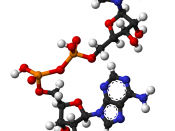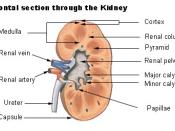Discussion.
Abundance of osmolytes. The results of the HPLC sample demonstrate the concentrations of five key osmolytes in the papilla and cortical regions of the kidney nephron. On almost all of these occasions the concentration of each osmolyte is greater in the papilla than in the cortex. This is consistent with research by Schmolke et al, 1991, where the distribution of total organic osmolytes was found to increase progressively form the outer cortex in towards the inner medullary regions of the papilla. Burg et al., 1990 also found a significantly greater distribution of GPC, Betaine and Sorbitol in the inner medulla of rat kidneys compared to the cortex during both diuresis and anti-diuresis. These organic osmolytes in the papilla are used during high osmolality to maintain cell volume without increasing ionic strength.
Western blotting technique show there is approximately 39 kDa of aldose reductase in the samples shown. This appears to be in both the papilla and cortical samples.
Effect of Lithium. Whole animal data shows clearly the impact of lithium treatment on concentrating urine and the urine excreted increases more than four fold indicating severe polyuria. There is no difference in the Na and K concentration in serum. However, when the two subject groups consume the same amount of water and excrete the same amount of urine there is a marked reduction in these ion levels in urine and in the osmotic pressure of urine following lithium treatment.
It has been previously established that the polyuria and decreased ability to concentrate urine in lithium-treated patients is in part due to a down regulation of aquaporin water channels. The results of this study support this concept, the images of the medulla show a reduction the clear expression of (brown stained) water channels.
Consistent with previous studies (Rojeck et al, 2005)...


